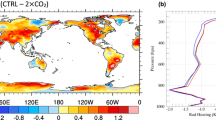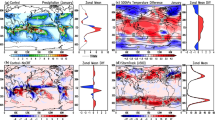Abstract
To better understand CFMIP/CMIP inter-model differences in rapid low cloud responses to CO2 increases and their associated effective radiative forcings, we examined the tropospheric adjustment of the lower tropospheric stability (LTS) in three general circulation models (GCMs): HadGEM2-A, MIROC3.2 medres, and MIROC5. MIROC3.2 medres showed a reduction in LTS over the sub-tropical ocean, in contrast to the other two models. This reduction was consistent with a temperature decrease in the mid-troposphere. The temperature decrease was mainly driven by instantaneous radiative forcing (RF) caused by an increase in CO2. Reductions in radiative and latent heating, due to clouds, and in adiabatic and advective heating, also contribute to the temperature decrease. The instantaneous RF in the mid-troposphere in MIROC3.2 medres is inconsistent with the results of line-by-line (LBL) calculations, and thus it is considered questionable. These results illustrate the importance of evaluating the vertical profile of instantaneous RF with LBL calculations; improved future model performance in this regard should help to increase our confidence in the tropospheric adjustment in GCMs.








Similar content being viewed by others
References
Anderson GP, Clough SA, Kneizys FX, Chetwynd JH, Shettle EP (1986) AFGL atmospheric constituent profiles (0–120 km), Tech Rep AFGL-TR-86-0110, Air Force Geophys Lab, Hanscom Air Force Base, MA
Andrews T, Forster PM (2008) CO2 forcing induces semi-direct effects with consequences for climate feedback interpretations. Geophys Res Lett 35:L04802. doi:10.1029/2007GL032273
Andrews T, Gregory JM, Webb MJ, Taylor KE (2012) Forcing, feedbacks and climate sensitivity in CMIP5 coupled atmosphere–ocean climate models. Geophys Res Lett 39:L09712. doi:10.1029/2012GL051607
Bala G, Caldeira K, Nemani R (2010) Fast versus slow response in climate change: implications for the global hydrological cycle. Clim Dyn 35:423–434. doi:10.1007/s00382-009-0583-y
Bellouin N, Boucher O, Haywood J, Johnson C, Jones A, Rae J, Woodward S (2007) Improved representation of aerosols for HadGEM2. Hadley Centre Tech Note 73, p 43
Bony S, Webb MJ, Bretherton CS, Klein SA, Siebesma P, Tselioudis G, Zhang M (2011) CFMIP: towards a better evaluation and understanding of clouds and cloud feedbacks in CMIP5 models. CLIVAR Exch 56, 16(2):20–24
Charlock TP, Ramanathan V (1985) The albedo field and cloud radiative forcing produced by a general circulation model with internally generated cloud optics. J Atmos Sci 42(13):1408–1429
Collins WD, Ramaswamy V, Schwarzkopf MD, Sun Y, Portmann RW, Fu Q, Casanova SEB, Dufresne JL, Fillmore DW, Forster PMD, Galin VY, Gohar LK, Ingram WJ, Kratz DP, Lefebvre MP, Li J, Marquet P, Oinas V, Tsushima Y, Uchiyama T, Zhong WY (2006) Radiative forcing by well-mixed greenhouse gases: estimates from climate models in the intergovernmental panel on climate change (IPCC) fourth assessment report (AR4). J Geophys Res 111:D14317. doi:10.1029/2005JD006713
Collins WJ, Bellouin N, Doutriaux-Boucher M, Gedney N, Hinton T, Jones CD, Liddicoat S, Martin G, O’Connor F, Rae J, Senior C, Totterdell I, Woodward S, Reichler T, Kim J (2008) Evaluation of the HadGEM2 model. Hadley Centre Tech Note 74, p 47
Colman RA, McAvaney BJ (2011) On tropospheric adjustment to forcing and climate feedbacks. Clim Dyn 36:1649–1658. doi:10.1007/s00382-011-1067-4
Cusack S, Edwards JM, Crowther JM (1999) Investigating k-distribution methods for parameterizing gaseous absorption in the Hadley Centre climate model. J Geophys Res 104:2051–2057
Dong B, Gregory JM, Sutton RT (2009) Understanding land-sea warming contrast in response to increasing greenhouse gases. Part I: transient adjustment. J Clim 22:3079–3097. doi:10.1175/2009JCLI2652.1
Edwards JM, Slingo A (1996) Studies with a flexible new radiation code. I: choosing a configuration for a large-scale model. Q J R Meteorol Soc 122:689–719
Ellingson RG, Ellis J, Fels S (1991) The intercomparison of radiation codes used in climate models: long wave results. J Geophys Res 96:8929–8953
Gregory JM, Webb MJ (2008) Tropospheric adjustment induces a cloud component in CO2 forcing. J Clim 21:58–71
Hansen J, Sato M, Ruedy R, Nazarenko L, Lacis A, Schmidt GA, Russell G, Aleinov I, Bauer M, Bauer S, Bell N, Cairns B, Canuto V, Chandler M, Cheng Y, Del Genio A, Faluvegi G, Fleming E, Friend A, Hall T, Jackman C, Kelley M, Kiang N, Koch D, Lean J, Lerner J, Lo K, Menon S, Miller R, Minnis P, Novakov T, Oinas V, Perlwitz Ja, Perlwitz Ju, Rind D, Romanou A, Shindell D, Stone P, Sun S, Tausnev N, Thresher D, Wielicki B, Wong T, Yao M, Zhang S (2005) Efficacy of climate forcings. J Geophys Res 110:D18104. doi:10.1029/2005JD005776
Hasumi H, Emori S (2004) K-1 coupled model (MIROC) description. K-1 technical report. Center for Climate System Research, the University of Tokyo, p 34. Available at http://www.ccsr.u-tokyo.ac.jp/kyosei/hasumi/MIROC/tech-repo.pdf
Kamae Y, Watanabe M (2012a) Tropospheric adjustment to increasing CO2: its timescale and the role of land–sea contrast. Clim Dyn. doi:10.1007/s00382-012-1555-1
Kamae Y, Watanabe M (2012b) On the robustness of tropospheric adjustment in CMIP5 models. Geophys Res Lett 39:L23808. doi:10.1029/2012GL054275
Klein SA, Hartmann DL (1993) The seasonal cycle of low stratiform clouds. J Clim 6(8):1587–1606
Nakajima T, Tsukamoto M, Tsushima Y, Numaguti A, Kimura T (2000) Modeling of the radiative process in an atmospheric general circulation model. Appl Opt 39(27):4869–4878
Ogura T, Emori S, Webb MJ, Tsushima Y, Yokohata T, Abe-Ouchi A, Kimoto M (2008a) Towards understanding cloud response in atmospheric GCMs: the use of tendency diagnostics. J Meteorol Soc Jpn 86(1):69–79
Ogura T, Webb MJ, Bodas-Salcedo A, Williams KD, Yokohata T, Wilson DR (2008b) Comparison of cloud response to CO2 doubling in two GCMs. SOLA 4:29–32. doi:10.2151/sola.2008-008
Randall DA, Wood RA, Bony S, Colman R, Fichefet T, Fyfe J, Kattsov V, Pitman A, Shukla J, Srinivasan J, Stouffer RJ, Sumi A, Taylor KE (2007) Climate models and their evaluation. In: Solomon S, Qin D, Manning M, Chen Z, Marquis MC, Averyt KB, Tignor M, Miller HL (eds) Climate change 2007: the physical science basis. Contribution of working group I to the fourth assessment report of the Intergovernmental Panel on Climate Change. Cambridge University Press, Cambridge and New York, pp 589–662
Rodwell MJ, Palmer TN (2007) Using numerical weather prediction to assess climate models. Q J R Meteorol Soc 133:129–146. doi:10.1002/qj.23
Sekiguchi M, Nakajima T (2008) A k-distribution-based radiation code and its computational optimization for an atmospheric general circulation model. JQSRT 109:2779–2793
Soden BJ, Broccoli AJ, Hemler RS (2004) On the use of cloud forcing to estimate cloud feedback. J Clim 17:3661–3665
Taylor KE, Williamson D, Zwiers F (2000) The sea surface temperature and sea-ice concentration boundary conditions for AMIP II simulations, PCMDI Report No. 60, Program for Climate Model Diagnosis and Intercomparison, Lawrence Livermore National Laboratory, Livermore, California, p 25
Taylor KE, Stouffer RJ, Meehl GA (2009) A summary of the CMIP5 experiment design. Available at http://cmip-pcmdi.llnl.gov/cmip5/experiment_design.html
Watanabe M, Suzuki T, O’ishi R, Komuro Y, Watanabe S, Emori S, Takemura T, Chikira M, Ogura T, Sekiguchi M, Takata K, Yamazaki D, Yokohata T, Nozawa T, Hasumi H, Tatebe H, Kimoto M (2010) Improved climate simulation by MIROC5: mean states, variability, and climate sensitivity. J Clim 23:6312–6335
Watanabe M, Shiogama H, Yoshimori M, Ogura T, Yokohata T, Okamoto H, Emori S, Kimoto M (2012) Fast and slow timescales in the tropical low-cloud response to increasing CO2 in two climate models. Clim Dyn 39:1627–1641. doi:10.1007/s00382-011-1178-y
Webb MJ, Lock AP (2012) Coupling between subtropical cloud feedback and the local hydrological cycle in a climate model. Clim Dyn doi:10.1007/s00382-012-1608-5
Webb MJ, Lambert FH, Gregory JM (2013) Origins of differences in climate sensitivity, forcing and feedback in climate models. Clim Dyn 40:677–707. doi:10.1007/s00382-012-1336-x
Williams KD, Brooks ME (2008) Initial tendencies of cloud regimes in the Met Office Unified Model. J Clim 21:833–840. doi:10.1175/2007JCLI1900.1
Williamson DL, Boyle J, Cederwall R, Fiorino M, Hnilo J, Olson J, Phillips T, Potter G, Xie SC (2005) Moisture and temperature balances at the Atmospheric Radiation Measurement Southern Great Plains Site in forecasts with the Community Atmosphere Model (CAM2). J Geophys Res 110:D15S16. doi:10.1029/2004JD005109
Wood R, Bretherton CS (2006) On the relationship between stratiform low cloud cover and lower tropospheric stability. J Clim 19:6425–6432
Wyant MC, Bretherton CS, Blossey PN (2009) Subtropical low cloud response to a warmer climate in a superparameterized climate model. Part I: regime sorting and physical mechanisms. J Adv Model Earth Syst 1(7). doi:10.3894/JAMES.2009.1.7
Wyant MC, Bretherton CS, Blossey PN, Khairoutdinov M (2012) Fast cloud adjustment to increasing CO2 in a superparameterized climate model. J Adv Model Earth Syst 4:M05001. doi:10.1029/2011MS000092
Zelinka MD, Klein SA, Hartmann DL (2012) Computing and partitioning cloud feedbacks using cloud property histograms. Part I: cloud radiative kernels. J Clim 25:3715–3735. doi:10.1175/JCLI-D-11-00248.1
Zelinka MD, Klein SA, Taylor KE, Andrews T, Webb MJ, Gregory JM, Forster PM (2013) Contributions of different cloud types to feedbacks and rapid adjustments in CMIP5. J Clim 26:5007–5027. doi:10.1175/JCLI-D-12-00555.1
Zhang M, Bretherton CS (2008) Mechanisms of low cloud-climate feedback in idealized single-column simulations with the Community Atmospheric Model, version 3 (CAM3). J Clim 21:4859–4878. doi:10.1175/2008JCLI2237.1
Zhang M, Bretherton CS, Blossey PN, Bony S, Brient F, Golaz JC (2012) The CGILS experimental design to investigate low cloud feedbacks in general circulation models by using single-column and large-eddy simulation models. J Adv Model Earth Syst 4:M12001. doi:10.1029/2012MS000182
Acknowledgments
We acknowledge the Radiative Transfer Model Intercomparison Project (RTMIP) for providing atmospheric profile and LBL data and the Atmospheric Radiation Measurement (ARM) Program for distributing the RTMIP data. We also acknowledge two anonymous reviewers for their constructive and insightful comments on the manuscript. This work was supported by the Program for Risk Information on Climate Change from the Ministry of Education, Culture, Sports, Science and Technology, Japan. This work was also supported by JSPS KAKENHI Grant Number 23310014 and 23340137. The contribution to this work from the Hadley Centre was supported by the Joint DECC/Defra Met Office Hadley Centre Climate Programme (GA01101) and funding from the European Union, Seventh Framework Programme (FP7/2007–2013), under Grant Agreement Number 244067 via the EU CLoud Intercomparison and Process Study Evaluation Project (EUCLIPSE). The Earth Simulator at JAMSTEC and the NEC SX-8R/128M16 at NIES were used to carry out the model simulations.
Author information
Authors and Affiliations
Corresponding author
Rights and permissions
About this article
Cite this article
Ogura, T., Webb, M.J., Watanabe, M. et al. Importance of instantaneous radiative forcing for rapid tropospheric adjustment. Clim Dyn 43, 1409–1421 (2014). https://doi.org/10.1007/s00382-013-1955-x
Received:
Accepted:
Published:
Issue Date:
DOI: https://doi.org/10.1007/s00382-013-1955-x




